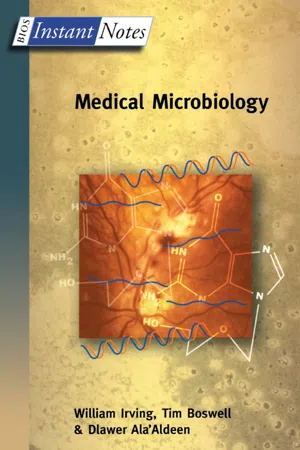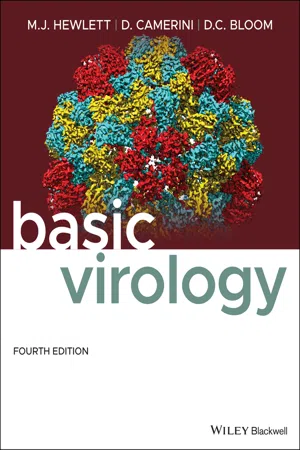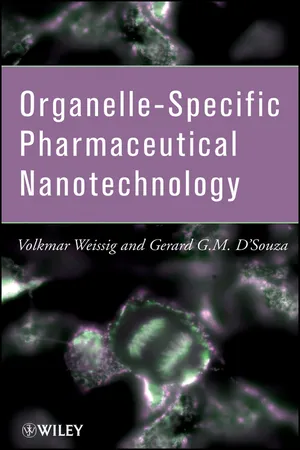Biological Sciences
Viral Envelopes
Viral envelopes are outer layers of some viruses, composed of a lipid bilayer derived from the host cell membrane. These envelopes play a crucial role in the virus's ability to infect host cells and evade the immune system. They contain viral glycoproteins that facilitate attachment to host cells and fusion of the viral envelope with the host cell membrane during the infection process.
Written by Perlego with AI-assistance
Related key terms
10 Key excerpts on "Viral Envelopes"
- eBook - ePub
A Guide to Virology for Engineers and Applied Scientists
Epidemiology, Emergency Management, and Optimization
- Megan M. Reynolds, Louis Theodore(Authors)
- 2023(Publication Date)
- Wiley(Publisher)
2017 , pp. 36).Virions are defined as complete virus particles with full infectivity. As noted, virus particles are only active once inside a host cell. This inactive state allows for protection from the external environment and facilitates the discovery of new host cells. The virion contains the neocapsid along with any enzymes needed for replication and any proteins on its surface that aid in the attachment process, which will be explained below.There are various ways to classify viruses, and the most basic grouping is centered simply on which genetic material they contain, either DNA or RNA. While cells have double‐stranded DNA and single‐stranded RNA, viruses can contain either double‐stranded or single‐stranded versions of either DNA or RNA. This categorization helps to predict some basic traits within groups, such as higher degree of mutations in RNA viruses due to the lack of proofreading within the cell.2.2 VIRAL LIFE CYCLE
Since virions only become active once they find a cell to invade, the virus life cycle is generally considered to begin with attachment to the host cell and to end with the destruction of that cell. When the host cell is destroyed, new virion copies are released into the extracellular environment. These virions are then free to continue the cycle by attacking nearby cells (Taylor 2014 ). The stages of viral replication are listed here and further explained in the subsections below (Louten 2016 ),- Attachment (Cell Connection)
- Penetration (Cell Entry)
- Uncoating
- Replication
- Assembly
- Maturation
- Release
These stages are also depicted in Figures 2.1 and 2.2 :Cell Connection and Entry. (Source: https://www.genome.gov/about-genomics/fact-sheets/Genomics-and-VirologyFigure 2.1 - eBook - ePub
- Jiri Mestecky, Michael E. Lamm, Pearay L. Ogra, Warren Strober, John Bienenstock, Jerry R. McGhee, Lloyd Mayer(Authors)
- 2005(Publication Date)
- Academic Press(Publisher)
Chapter 41 Virus Infection of Epithelial CellsRichard W. Compans Department of Microbiology and Immunology, Emory University School of Medicine, Atlanta, GeorgiaGeorg Herrler Institut für Virologie, Tierärztliche Hochschule Hannover, Hannover, GermanyVIRUS LIFE CYCLE
Viruses contain a genome consisting of either DNA or RNA, which is surrounded by a protein coat that is usually assembled in either an icosahedral or helical configuration. In many viruses the core is enclosed in a lipid-containing membrane called the viral envelope, which consists of a lipid bilayer containing one or more virus-coded surface glycoproteins. The structural properties of virus particles (virions) provide the basis for their classification into families. Important features that distinguish each family are the size and type of nucleic acid, the size and symmetry of the nucleocapsid, and the presence or absence of an envelope. Based on these and a few other characteristics, animal viruses have been classified into families, each of which has a characteristic virion structure and a common replication strategy.The viral replication cycle is initiated by adsorption of the virion to host cell receptors, which are described in more detail in the next section. Following adsorption, enveloped viruses enter cells by a process of membrane fusion, which may be either low pH–dependent or pH-independent (White, 1992 ), and is mediated by specific viral glycoproteins. The pH-independent fusion occurs directly with the cellular plasma membrane; such fusion has been well documented for paramyxoviruses and certain retroviruses. In contrast, many other enveloped viruses enter cells by endocytosis. They subsequently are localized in endosomes, and the low pH of the endosome triggers a conformational change in the viral glycoprotein that activates their membrane fusion activity. The viral envelope then fuses with the surrounding endosomal membrane. The best-studied example of this fusion mechanism is with influenza virus, for which the molecular structure of the fusion protein (hemagglutinin) has been determined in both its neutral pH form (Wilson et al., 1981) and its low pH form (Bullough et al., - eBook - ePub
- William Irving, Tim Boswell, Dlawer Ala'Aldeen(Authors)
- 2004(Publication Date)
- Taylor & Francis(Publisher)
Many viruses subvert host cell function in order to divert the activity of the cell towards production of virus particles. Viruses must also prevent the natural defense mechanisms of the host cell and the host immune system from eliminating the cell by apoptosis (cellular suicide) or by T-cell cytotoxicity, as this would result in prevention of virus replication. Thus, there are many regulatory proteins encoded by viruses which can switch off host cell macromolecular synthesis, prevent host cells from undergoing apoptosis, and prevent recognition of infected cells by circulating T cells (e.g. by reducing the expression of HLA molecules on the cell surface). Viral Envelopes. These are composed of lipid, and derived from membranes of the host cell, acquired as the virus buds through when exiting the cell. As the lipid envelope is on the outside of the virus, the viral attachment proteins must be inserted into the envelope. If the envelope is stripped off, the attachment proteins are also removed, rendering the virus non-infective. Stripping lipid envelopes is a relatively easy thing to do (e.g. with 70% alcohol, or detergents). Enveloped viruses are therefore generally more fragile and more easily inactivated than non-enveloped ones. Classification of viruses More than 4000 different viruses have been described. These are grouped together into 69 large families (designated by the suffix -viridae), in turn sub-divided into subfamilies (designated by the suffix -virinae) and 243 genera (designated by the suffix -virus) on the basis of a number of characteristics, as defined by The International Committee on Taxonomy of Viruses. Genera are comprised of strains or species. The characteristics used to assign a given virus to a given family include the nature of the viral genome, the geometric symmetry of the capsid, the presence or absence of a lipid envelope, and, if known, the size and shape of virus particles as seen by electron microscopy - eBook - ePub
- Martinez J. Hewlett, David Camerini, David C. Bloom(Authors)
- 2021(Publication Date)
- Wiley-Blackwell(Publisher)
Chapter 20 .Generation of the virion envelope and egress of the enveloped virion
The lipid bilayer of the membrane envelope of the viruses that bear them is derived from the infected cell. Few (if any) viral genes directed toward lipid biosynthesis or membrane assembly are yet identified. While the lipid bilayer is entirely cellular, the envelope is made virus specific by the insertion of one or several virus‐encoded membrane proteins that are synthesized during the replication cycle.Some of the patterns of envelopment at the plasma membrane for viruses that assemble in the cytoplasm are shown in Figure 6.8 . Viral glycoproteins, originally synthesized at the rough endoplasmic reticulum and then processed through the Golgi apparatus, arrive at the site of budding with their carboxy termini in the cytoplasm and their amino termini on the outside of the cell. At both sites, enveloped viruses recruit cellular proteins needed to pinch off the cytoplasmic membrane stalk connecting the budding enveloped particle to the cell surface.Figure 6.8 Insertion of glycoproteins into the cell's membrane structures and formation of the viral envelope. The formation of viral glycoproteins on the rough endoplasmic reticulum parallels that of cellular glycoproteins except that viral mRNA is translated (a). Full glycosylation takes place in the Golgi bodies, and viral glycoproteins are incorporated into transport vesicles for movement to the cell membrane where they are inserted (b). At the same time (c), viral capsids assembly and then associate with virus‐modified membranes. This can involve the interaction with virus‐encoded matrix proteins that serve as “adapters.” Budding takes place (d, e) as a function of the interaction between viral capsid and matrix proteins and the modified cellular envelope containing viral glycoproteins.Many viruses, including retroviruses, bud from the surface of the infected cell. The use of atomic force microscopy (outlined in Part III , Chapter 9 ) has provided dramatic visualization of this process as shown in Figure 6.9 - eBook - ePub
Studies in Viral Ecology, Volume 2
Animal Host Systems
- Christon J. Hurst(Author)
- 2011(Publication Date)
- Wiley-Blackwell(Publisher)
Figure 3.3 ). The matrix proteins are therefore likely to interact with the lipid bilayer and transmembrane proteins of the viral envelope on the outer side and with the nucleocapsid on the inner side. Matrix proteins are also usually the most abundant proteins in enveloped virus particles and are critical for the budding of enveloped viruses. Some enveloped viruses containing icosahedral capsids do not possess typical matrix proteins around the nucleocapsids underneath the membrane (e.g., togaviruses).Viruses vary greatly in size and shape. They can be spherical, cylindrical (rod shaped), or even pleomorphic (Figures 3.1 and 3.4 ). Primarily, the virus structure is determined by the nature of the capsid and whether the capsid is naked or surrounded by an envelope. The structure of the capsid is in part determined by the protein and nucleic acid (nucleocapsid) interactions, but principally by the protein–protein interactions of the capsid protein(s). In most cases, the nucleic acid is incorporated after the majority of the protein shell of the capsid has been formed, or capsids can remain empty, resulting in noninfectious virus particles. The capsids are composed of repeating protein subunits called capsomeres. Capsomeres are composed of multimeric units of a single protein, or often heteromeric units of more than one protein.3.2.3 LipidsIn addition to nucleic acids (DNA or RNA) and proteins, enveloped viruses contain lipids in their membrane. These lipids constitute integral components of viruses and are critically involved in many aspects of virus life cycle including entry, fusion, uncoating, and delivery of viral genome into the host cell for initiating the infectious cycle; transport and assembly of viral components; and budding and release of virus particles. Although viruses bud from host membranes and all viral lipids are acquired from the host membranes, some of the viral lipids do not match quantitatively with that of the host membranes. A number of factors are involved in the selection of viral lipids, including the budding site of enveloped viruses in the infected cells and the type of cells in which viruses are grown, as well as the type of organelles such as plasma membrane, Golgi complex, nucleus, and so on from which the virus buds. Since different cell types and subcellular organelles possess varying lipid composition, viruses budding from membranes of different organelles will have different lipid composition. For example, herpesvirus, a complex DNA virus, buds from the inner nuclear membrane. However, fully mature infectious herpesvirus exits from the basal layer of infected epithelial cells. Hepadna, rota, and spuma viruses bud from the endoplasmic reticulum (ER). Coronaviruses (family Coronaviridae) and vaccinia virus (family Poxviridae, genus Orthopoxvirus ) acquire their envelope from the intermediate pre-Golgi compartment (IC). Vaccinia virus is further surrounded by membrane envelope, which is a part of complex maturation process, before being released from the plasma membrane. Bunyaviruses (family Bunyaviridae) and togaviruses (family Togaviridae, genera Alphavirus and Rubivirus ) acquire their envelope on the Golgi complex. However, whereas Sindbis virus (SIN, family Togaviridae, genus Alphavirus ) exits from the apical membrane, Semliki Forest virus (SFV, also family Togaviridae, genus Alphavirus - eBook - ePub
Studies in Viral Ecology, Volume 1
Microbial and Botanical Host Systems
- Christon J. Hurst(Author)
- 2011(Publication Date)
- Wiley-Blackwell(Publisher)
The nucleic acid is the genome that contains the information necessary for viral function and multiplication, and this information is passed from the parent to progeny viruses. Some viruses contain extragenomic nucleic acid, for example, tRNA in retroviruses (family Retroviridae) and ribosomal RNA in arenaviruses (family Arenaviridae). Viral proteins have three primary functions: (1) they provide the shell to protect the nucleic acid from degradation by environmental nucleases, (2) facilitate transfer of the genome from virus to host and from one host to another, and (3) provide many of the enzymatic and regulatory functions needed for transcription and replication so that viruses can survive, multiply, and perpetuate. In addition to the capsid shell, many viruses also possess an envelope (or viral membrane) around the nucleocapsid. The envelope in these viruses is critical for their transmission from one host to another. The naked nucleocapsids of enveloped viruses are noninfectious or poorly infectious because they lack the viral receptor binding protein for attachment to the host receptor. The viral envelope contains lipids and carbohydrates in addition to “envelope- or membrane-associated” viral proteins. The viral genome codes for most, if not all, of the proteins associated with the viral envelope. Lipids of the viral membrane, on the other hand, are synthesized by the host cell and derived from it. Therefore, viral lipid composition varies depending on the host cell in which the virus grows and also on the type of the cellular membrane (e.g., ER, Golgi, plasma, or nuclear membrane) from which the particular type of virus buds. However, lipid composition of viral membrane does not completely mimic that of the cellular membrane but rather is selectively enriched in specific host lipid components - eBook - ePub
- Volkmar Weissig, Gerard G. D'Souza(Authors)
- 2011(Publication Date)
- Wiley(Publisher)
The scale bar is 100 µm for each image. The capsid is indicated by the asterisk and the lipid bilayer (best seen in the cryoelectron microscopy image) is indicated by the arrowhead. In each case the eGPs project from the lipid bilayer but are poorly visible. Biochemical composition is a third criterion used to classify viruses and is the most relevant to later sections of this chapter. All viruses contain protein, either encoded by the virus genome or taken from infected cells, but a major distinction is the presence of a bounding lipid bilayer that is also derived from the cell membrane when virus buds from the cell. Viruses that have lipid membranes are termed enveloped viruses and will be the main subject of this chapter. They are special, as embedded in the membrane are the viral eGPs. Often called “spike” proteins, the eGPs project from the virus membrane and are responsible for the initial interaction with the cell as well as catalyzing fusion of the virus and cell membrane. Since the lipid bilayer encapsulates the virus core, fusion of virus and cell membranes results in the seamless merging of virus and cell membranes to release the core into the cell cytoplasm. The ability of the eGP to induce membrane fusion of lipid bilayers, and the fact that the majority of eGPs are structurally distinct functional units that operate independently from the other virus proteins that underlie the membrane, offers great advantages over nonenveloped virus proteins since the size and composition of the cargo are not restricted and simply need to be bound in a lipid bilayer. 20.3 ENVELOPE GLYCOPROTEIN STRUCTURE, FUNCTION, AND CLASSIFICATION eGPs are multifunctional proteins that bind to specific surface-exposed receptors on cells and allow the virus to penetrate into the cell cytoplasm. Both these properties are highly desirable aspects of a nanocargo delivery mechanism - James F. Zachary(Author)
- 2016(Publication Date)
- Mosby(Publisher)
In general, nonenveloped viruses (viral protein coats or capsids) are released from target cells only when cell lysis occurs, whereas enveloped viruses are released from target cells by budding from cell membrane, and the cell usually does not lyse (a viable cell remains) except for infections with herpesviruses (see later). Enveloped viruses with envelope glycoproteins must acquire an envelope by budding through cellular membranes such as the plasma membrane, membranes of the Golgi complex or rough endoplasmic reticulum, or nuclear membrane. During transcription and translation of viral genes and proteins, new viral envelope glycoproteins are inserted into target cell membranes of the ER and Golgi apparatus as examples (i.e., cytocavitary system) and then moved to specific locations in cell membrane within the cell. These are the sites where virus buds from target cell membrane and acquires envelope glycoproteins. Most viruses that bud from the cell membrane do not cause cell lysis except for those that bud from the Golgi complex or rough endoplasmic reticulum (flavivirus, coronavirus, arterivirus, and bunyavirus) or the nuclear membrane (herpesvirus).Virus capsid proteins and envelope glycoproteins are used immunologically as a means to clinically prevent (e.g., vaccination) or control (e.g., pharmaceutical products) diseases caused by viruses by developing strategies to block one of more of the steps in the viral attachment or replication cycle. Antibiotics have no effect on viruses; however, fortunately, viral infections (viral antigens) usually activate host innate and adaptive defense mechanisms and cause an immune response (cell-mediated), which can completely eliminate a virus or prevent an infection by a virus (vaccination). However, these defensive responses can also injure and lyse target cells, leading to disease. The list of structural and biochemical effects that viruses have on target cells is extensive. These effects are often called cytopathic effects- eBook - ePub
Rhabdoviruses
Volume I
- D. H. L. Bishop(Author)
- 2018(Publication Date)
- CRC Press(Publisher)
Wells, H. J., and Hummeler, K., Comparison of the lipids of intracellular and extracellular rabies viruses, J. Virol., 12, 1028, 1973.58 . Blough, H. A. and Tiffany, J. M., Theoretical aspects of structure and assembly of Viral Envelopes, Curr. Top. Microbiol. Immunol., 70, 1, 1975.59 . Lenard, J., Virus envelopes and plasma membranes, Annu. Rev. Biophys. Bioeng., 7, 139, 1978.60 . Stoffel, W. and Bister, K., 13C nuclear magnetic resononce studies on the lipid organization in enveloped virions (vesicular stomatitis virus), Biochemistry, 13, 2841, 1975.61 . Stoffel, W., Bister, K., Schreiber, C., and Tunggal, B., 13 C-NMR studies of the membrane structure in enveloped virions (vesicular stomatitis virus), Hoppe-Seyler’s Z. Physiol. Chem., 357, 905, 1976.62 . Barenholz, Y., Moore, N. F., and Wagner, R. R., Enveloped viruses as model membrane systems: microviscosity of vesicular stomatitis virus and host cell membranes, Biochemistry, 15, 3563, 1976.63 . Moore, N. F., Patzer, E. J., Wagner, R. R., Yeagle, P. L., Hutton, W. C., and Martin, R. B., The structure of vesicular stomatitis virus membrane: a phosphorus nuclear magnetic resonance approach, Biochim. Biophys. Acta, 464, 234, 1977.64 . Mudd, H. A., Glycoprotein fragment associated with vesicular stomatitis virus after proteolytic digestion, Virology, 62, 573, 1974.65 . Landsberger, F., personal communication, 1978.66 . McAllister, P. E. and Wagner, R. R., Virion RNA polzmerases of two salmonid rhabdoviruses, J. Virol., 22, 838, 1977.67 . Sokol, F. and Clark, H. F., Phosphoproteins: structural components of rhabdoviruses, Virology, 52, 246, 1973.68 . Sokol, F., Clark, H. F., Wiktor, T. J., McFalls, M. L., Bishop, D. H. L., and Obijeski, J. F., Structural phosphoproteins associated with ten rhabdoviruses, J. Gen. Virol - eBook - ePub
- P. J. Quinn, B. K. Markey, F. C. Leonard, P. Hartigan, S. Fanning, E. S. Fitzpatrick(Authors)
- 2011(Publication Date)
- Wiley-Blackwell(Publisher)
The mechanisms for the assembly and release of enveloped and non-enveloped viruses are distinct. Non-enveloped viruses of animals have an icosahedral structure. The structural proteins of these viruses associate spontaneously in a symmetrical and stepwise fashion to form procapsids. Subsequently, viral nucleic acid is incorporated into the procapsid. Proteolytic cleavage of specific procapsid polypeptides may be required for the final formation of infectious particles. Non-enveloped viruses are usually released following cellular disintegration (lysis). The assembly of picor-naviruses and reoviruses occurs in the cytoplasm of the cell whereas parvoviruses, adenoviruses and papillomaviruses are assembled in the nucleus.In enveloped viruses, the final step in the process of virion assembly involves acquisition of an envelope by budding from cell membranes. Prior to budding, cell membranes are modified by the insertion of virus-specified transmembrane glycoproteins which aggregate in patches in the plasma membrane. The presence of viral glycoproteins alters the antigenic composition of infected cells, which subsequently can become targets for cytotoxic T lymphocytes. Togavirus nucleo-capsids bind to the hydrophilic domains of the virus-specified membrane proteins which project slightly into the cytoplasm and become surrounded by the altered portion of membrane. The nucleocapsids of helical viruses bind to a virus-specified matrix protein which lines the cytoplasmic side of membrane patches.Budding of viruses through the plasma membrane does not usually breach the integrity of the membrane and, as a result, many enveloped viruses are non-cytopathic and may be associated with persistent infections. Assembly of retrovirus virions occurs by two main pathways: for retroviruses with C-type morphology, capsid assembly and envelopment occurs concurrently at the plasma membrane; in the case of capsid assembly of retroviruses with B-type and D-type morphology, it occurs at an intracytoplasmic, pericentriolar assembly site, followed by transportation to the plasma membrane and budding. Non-cytopathic viruses need to avoid rebinding to receptors on the host cell, so that efficient spread to neighbouring target cells can occur. Orthomyxoviruses and para-myxoviruses incorporate a sialidase enzyme in their envelope to promote destruction of terminal sialic acid residues on the cellular receptors used for viral attachment on the host cell surface. In the case of influenza virus, the neuraminidase is critical for virus release as it prevents nascent virions from attaching to the host cell surface receptors and to each other. Retroviruses produce an over-abundance of viral glycoproteins such that cellular receptors are bound by their ligand as they are transported to the cell surface resulting in removal or down-regulation of the receptor. Unlike most other enveloped viruses, togaviruses, paramyxoviruses and rhabdoviruses are cytolytic. Flaviviruses, coronaviruses, arteriviruses and bunyaviruses acquire their envelopes inside cells by budding through the membranes of the rough endoplasmic reticulum or the Golgi apparatus. These viruses are then transported in vesicles to the cell surface where the vesicle fuses with the plasma membrane, releasing the virion by exocytosis Herpesviruses, which replicate in the nucleus, are unique in that they bud through the inner lamella of the nuclear membrane and accumulate in the space between inner and outer lamellae, in the cisternae of the endoplasmic reticulum and in cytoplasmic vesicles (Fig. 55.2
Index pages curate the most relevant extracts from our library of academic textbooks. They’ve been created using an in-house natural language model (NLM), each adding context and meaning to key research topics.









